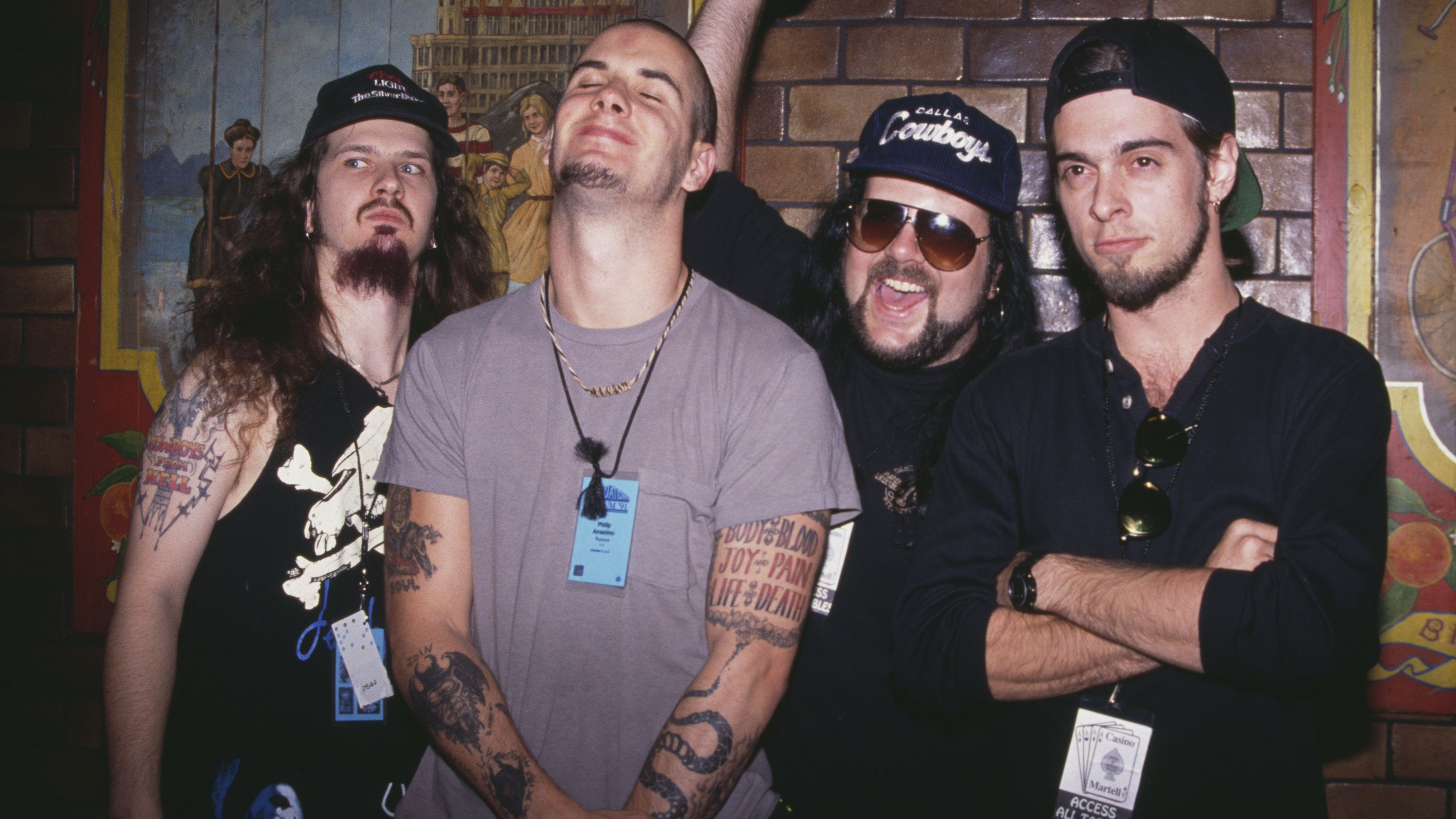“No Pro Tools, no tricks or whistles. We as a band helped change the production of heavy metal records”: With one song, Pantera reinvented their sound to become one of the most influential metal bands of all time
And the solo from Dimebag gave the world its first taste of a new guitar hero

The lead single and title track from Pantera’s fifth album effectively served as a mission statement for a new phase of their career, announcing who they were and what they were hoping to achieve.
Released in 1990, Cowboys From Hell was the sound of the Texan band drawing a line through the four glam-influenced records they’d released during the ’80s and starting afresh, with a more aggressive sonic template that would lay the blueprint for the ‘groove metal’ movement that soon followed.
In a 2010 interview with Metal Hammer, drummer Vinnie Paul admitted that after their fourth album, 1988’s Power Metal, the band looked at themselves and realised change would be needed for their major label debut.
“We decided to drop the image and focus more on the music and kick as much ass as possible,” he remarked, noting: “These fancy clothes and all this crazy hair ain’t playing music for us!”
With the benefit of hindsight, it would be fair to say many asses were kicked.
Cowboys From Hell starts with a strange swirling noise that isn’t a million miles away from the rhythmic churn of a train engine before guitarist Dimebag Darrell introduces the song’s signature riff.
“That whooshing noise at the beginning was a loop we made for Dime to play over,” bassist Rex Brown once told Metal Hammer. “And it was very repetitious and very fuckin’ annoying for a long while. He developed that whole riff over that.”
Want all the hottest music and gear news, reviews, deals, features and more, direct to your inbox? Sign up here.
The riff in question ended up becoming one of Pantera’s most recognisable calling cards, played an octave up around the 12th fret before moving the same idea all the way down to open position right as the drums come in.
The idea itself is built off the E Minor blues scale – a sound that Dimebag Darrell and Vinnie Paul picked up from their country music producer father Jerry Abbott.
“That riff is a little form of in-the-box blues scaling,” Rex Brown once noted. “We were always down the street watching all these great blues guys in the studio because Vinnie and Darrell’s dad was an engineer at Pantego Studio. We’d sneak in the studio and sit way underneath the board listening to all this great stuff.”
Brown added: “I think that’s where Dime got the idea for that intro to Cowboys. He started it as a kind of modal exercise because he would practise it forwards and backwards.”
The roots of the song go right back to 1989, when Dimebag supposedly arrived late to a house party in Fort Worth, Texas and told the band’s singer Phil Anselmo that he had a new riff to show him. The pair then walked over to the guitarist’s car and upon hearing the riff, Anselmo instantly knew it was an anthem in the making.
“Well, there was no denying the power of the actual song Cowboys from Hell,” Anselmo told American news website Examiner in 2010. “We knew that was an anthem, for sure. And we knew it was one of our better songs as far as being memorable.”
As for the history behind the title itself, Anselmo once revealed it was inspired by the liner notes of an album recorded by a thrash metal band.
“It was one of them Bay Area bands, I’m thinking of course it was Metallica,” he revealed. “Thinking maybe it was Ride The Lightning, but I could swear it’s Kill ’Em All.”
He continued: “You go through the ‘thank you’ list, on the back of that record they thank the crew people, and then they call them the cowboys from hell. I remember when Darrell played me that riff from Cowboys From Hell, I was like, ‘Goddamn, that would be a fantastic title for the song!’ It was perfect.”
For the recording, Dimebag used his 1981 blue Dean From Hell guitar, which featured a Bill Lawrence XL500 pickup in the bridge and a Seymour Duncan ’59 in the neck, in standard tuning.
The guitar was plugged into a Randall RG100H head with the gain, bass and treble set high and the mids set low.
This infamous ‘mid scoop’ would influence multiple generations of guitar players to come.
“We get asked a lot about the production and whatnot – it being pretty high-end and tinny,” Anselmo told Scottish culture magazine The Skinny in 2010. “All I can say is I think at the time we were really trying to figure out the best way to take the monstrous guitar sound that Darrell had and put it on a record.”
He continued: “You have to understand, we recorded that fucker in 1989 – no Pro Tools, no tricks or whistles. We had to really track that thing.
“We as a band helped change the production of heavy metal records. Cowboys From Hell was a launch pad in many respects – not the actual full figured-out article yet, but it was a great starting point.”
The solo gave the world its first taste of a new guitar hero in the metal scene. Dimebag was very much the full package – blessed with an exceptionally rare ability to both shred and riff like a supreme being.
The solo section begins with some moody discordance between the E root note and its tritone interval Bb – a sound that can be traced back to Black Sabbath’s hugely influential self-titled track of 1970.
Then there are some chromatic ideas where Dimebag plays the 11th, 12th and 15th fret of every string twice – creating tension with notes that are out of key and resolving with the ones that are diatonic.
After some bluesy runs based around the 12th, 14th and 15th frets of the higher strings, Dimebag then introduces two notes that move up chromatically before one final big bend on the 22nd fret of his high E-string.
Cowboys From Hell was the first song written for the album, although by the time they were finishing it, the four members were unconvinced of its merits, feeling it was too tame and commercial compared to the tracks written after it.
Their manager at the time, Walter O’Brien, thankfully managed to convince them otherwise.
“I knew that Pantera were going to be called the Cowboys from Hell from then on,” O’Brien once revealed. “Every great band has a nickname. Bruce Springsteen is the Boss. ZZ Top is that Little Ol’ Band from Texas.”
He added: “Cowboys from Hell was perfect for them. I rarely insist on anything creative from a band, but I just knew it was a massive song. Dimebag put the CFH logo on everything, and he lived that persona.”
Amit has been writing for titles like Total Guitar, MusicRadar and Guitar World for over a decade and counts Richie Kotzen, Guthrie Govan and Jeff Beck among his primary influences. He's interviewed everyone from Ozzy Osbourne and Lemmy to Slash and Jimmy Page, and once even traded solos with a member of Slayer on a track released internationally. As a session guitarist, he's played alongside members of Judas Priest and Uriah Heep in London ensemble Metalworks, as well as handling lead guitars for legends like Glen Matlock (Sex Pistols, The Faces) and Stu Hamm (Steve Vai, Joe Satriani, G3).
You must confirm your public display name before commenting
Please logout and then login again, you will then be prompted to enter your display name.
![Pantera - Cowboys From Hell (Official Music Video) [4K Remaster] - YouTube](https://img.youtube.com/vi/i97OkCXwotE/maxresdefault.jpg)
![Pantera - Cowboys From Hell (Live, Moscow '91) [HD] - YouTube](https://img.youtube.com/vi/UgOyXKanKHc/maxresdefault.jpg)
